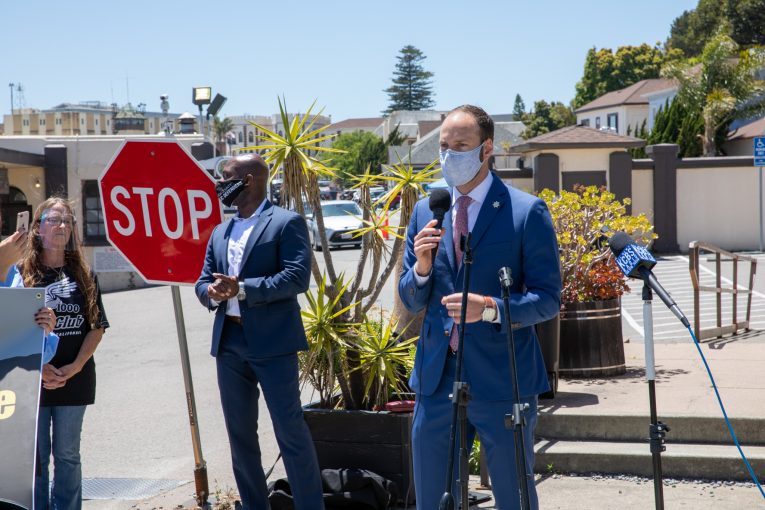

Ten days ago, legislators and reformers gathered at San Quentin to call for Governor Newsom to release prisoners in following recommendations from public health experts to stem the rampant outbreak of COVID-19 in San Quentin and other California prisons.
In response, Governor Newsom ordered the release of 8000 incarcerated people, those who had less than a year left on their sentence—but that represents only a small portion of those needed to be released.
Chesa Boudin and Miriam Krinsky wrote in an op-ed “that represents under 8 percent of an already overcrowded state prison population and a far larger number — nearly 50 percent of the population — has being classified by California Department of Corrections and Rehabilitation’s own data as ‘low risk.’”
Moreover, they argue “this action comes too late to prevent the explosive and deadly outbreak at the overcrowded San Quentin prison and to save the lives of over 30 people behind bars who have died from COVID-19.”
As San Francisco District Attorney Chesa Boudin pointed out at the time, district attorneys have tools right now to help this process. They can move for resentencing under Penal Code section 1170(d). But it’s a tool that other DAs are reluctant to employ. San Francisco has seen 15 incarcerated people resentenced and released under 1170(d) so far—more than all other counties combined.
AB 2942 took effect on January 1, sponsored by Assemblymember Phil Ting, and the law amended 1170(d) to allow DAs to review old cases and recommend a reduced sentence if they believe that the punishment is unduly harsh and no longer serves the interests of justice.
The petition goes to court in each case and the judge makes the determination as to whether to change the sentence. Among the factors considered: disciplinary record, work toward rehabilitation, evidence of future  violence, and changes of circumstances.
violence, and changes of circumstances.
But as we now see, the 1170(d) route is a slow process—it requires a motion to a judge who then has order the re-sentencing.
Dana Drusinsky from the San Francisco District Attorney’s Office’s conviction review unit has been looking to identify cases of people who have been sentenced to extreme sentences. She said they started the process looking at Three Strikes cases. But given the COVID outbreak, she explained that they quickly shifted to focusing on people in San Quentin. She said that the office is reviewing all cases of people serving time in San Quentin from San Francisco cases. She noted that other attorneys in the office have offered to volunteer to help in light of the crisis in San Quentin.
One person who was resentenced last Monday had initially received a sentence of 125 years to life. He had committed a robbery in 1994, which was a third strike, and he then got into a vehicle driven by another person and it hit a police vehicle. One officer suffered a minor injury.
The police, she explained, responded by shooting him. When they stacked all of the charges, he received a 125 years to life sentence in an incident where no one was significantly injured or hurt.
Drusinsky explained that the reviewing judge agreed that the sentence was excessive. The judge ordered the resentencing and the person should be out of prison after 26 years.
Drusinsky emphasized that despite the fact that he has a de facto LWOP sentence, he had performed well in prisons, without any significant violations.
A big obstacle so far in reviewing sentences has been getting what is called the C-file from San Quentin. The C-file is the file maintained by CDCR which contains reports, evaluations, and correspondence involving each person incarcerated in the system.
This is an important part of the review process, because it allows the DA’s office to see how people are performing in prison.
The documents are protected for confidentiality. Drusinsky explained that the office either obtains a waiver from the person in prison or subpoenas the documents on their own. She noted that it has been challenging, but that the CDCR, to its credit, has worked hard to help expedite the process. Despite cooperation, “there have still been bottlenecks.”
Right now they are mailing waivers to incarcerated people for them to sign then return to the DA’s office, and they then evaluate the C-files to see how they have performed in prison.
Drusinky explained that if the person is deemed appropriate for re-sentencing, the District Attorney’s Office will contact the public defender’s office or the person’s attorney. The defense attorney then works on a mitigation packet or a re-entry plan. She credited the San Francisco Public Defender’s Office in particular for their “phenomenal” work in creating strong reentry plans for their clients. She explained that after a plan is in place and all the materials have been gathered, the judge reviews everything and makes a decision.
Under normal conditions you might find people in prison reluctant to share their C-file with a prosecutor, but the District Attorney’s Office’s letter explains that they are reviewing all cases for possible resentencing and that seems to be getting many people to sign and return the waiver in hopes that they might be eligible for early release.
The key so far—everyone has had a strong reentry plan. That includes the provision of housing. They are connected to clinics that provide mental health support, and they are connected to social workers who help them access Medicare.
The DA’s office has also partnered with other organizations to provide mentors—usually formerly incarcerated people who are trying to help.
There are of course those who will have concerns about public safety, as they assume anytime someone is released from prison it poses a public safety risk. But Drusinksy explained that the office has been thorough in its review of cases, and that the people resentenced have had strong reentry plans designed to keep them on track.
She noted that the District Attorney’s Office contacts the victims in every single case.
She explained that many times the victims agree with re-sentencing, noting that many of the people who are being resentenced have already served lengthy prison sentences, even several decades long. She explained that the risk of recidivism for many of these people is quite low, especially considering their ages upon release.
The key question—is this a path forward to reducing prison population?
Drusinksy noted that some DAs in the state have been working with Hillary Blout from the Sentencing Project to get help in trying to release people.
But this is an extremely time-consuming process.
It can take weeks from start to finish to review someone’s case and have a resentencing hearing. Drusinsky noted again that they contact victims in every case, as required by state law, and ensure they are part of the process.
The frustrating part is that this is a slow and careful process—designed more to right individual cases of overly harsh sentences rather than systemic problems or immediate crises.
As Drusinsky noted, the process differs from the way the Governor can release people; he has the power to order someone released, but, pursuant to a law passed in 2018, if the DA wants someone resentenced, the DA has to file a motion and ultimately leave it to a judge to determine based on numerous factors. She emphasized that this process makes it challenging to have people resentenced as quickly as she would like.
—David M. Greenwald reporting
To sign up for our new newsletter – Everyday Injustice – https://tinyurl.com/yyultcf9






